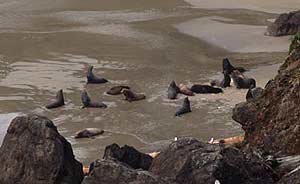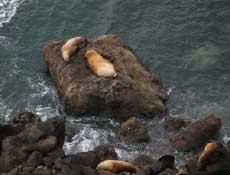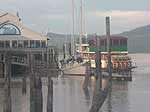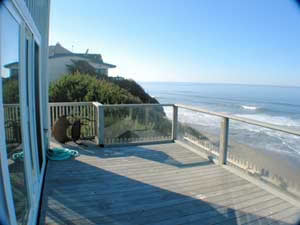
BEACH
NEWS YOU CAN USE
Summer Brings Unusual Natural Events to Oregon Coast (Oregon Coast) – It all began in late spring, when Killer whales were spotted around the Sea Lion caves as well as close to shore in Seaside – both rather unusual occurrences. Then, the natural world on Oregon’s coast saw new seal pups being born, strange glowing sands and other oddball finds that have made the news throughout summer. It's a combination of science and tourism that is proving irresistable to many visitors.
Early June also saw more rare whale sightings and some big news for those in Florence and Seaside. Tiffany Boothe, who usually provides the news media with shots of the on-goings of the Seaside Aquarium, made the regional news herself when she spotted and photographed a quartet of Orcas on the central coast, near Florence - some 160 miles from her place of residence.
Boothe was returning from Eugene and on a whim decided to take the long drive up the coast from Florence to Seaside. She pulled over at one of the pullouts between Sea Lion Caves and Heceta Head, where the cliffs plunge a few hundred feet into the ocean, while still providing perches and rookeries for sea lions. “I had been admiring how calm the ocean looked for a while and decided to stop off at the next pull over, which was looking out toward the light house,” Boothe said. “I thought that with the surface of the ocean resembling glass, if there were whales out there to be seen I would see them. It's that time of year when the grey whales migrate up to their summer feeding grounds in Alaska. When I turned off my car engine, I immediately heard the roaring of what could only be sea lions. Indeed, there was a small colony of California sea lions just below. “After I stretched my legs a bit and took a few photos, I heard a splashing and wooshing sound, and I thought, ‘No way, it can’t be.’ But sure enough, as I looked down, I saw four Orcas cruising on by.”
Mary Jacobson at the Sea Lion Caves was amazed to hear about the sighting, and no one there had seen anything since the previously publicized sightings. Boothe reported the small pod looked as if it was made up of three adults and one juvenile. Jacobson said the pod they had spotted had that composition as well, confirming that both sightings were the same pod.
“Though they weren't the whales I expected to see, it was an amazing sight,” Boothe said. Boothe used a camera that zoomed in by a factor of 150, and reported the whales were very close to shore. She watched them swim northward, but was unable to follow them because there were no more high vantage points from which to see them.
Jacobson said the Orcas that had been in the area have not alarmed the sea lions nearby, although they often hunt these creatures. Jacobson said the Orcas had been seen swimming and diving near a group of about 50 sea lions that were swimming in the ocean, doing what she said looked like “training maneuvers for whales.” But the sea lions did not move onto nearby rocks and didn’t seem threatened, she said. Boothe also reported the same thing, saying she saw the whales swimming near the sea lions but not alarming them.
Cecil was the offspring of the ten-year-old female Greta. The following week, two other seals gave birth over the course of a few days from parents Cosmo and Scully. Those seals were then named by the family which owns the aquarium.
There was another strange find not too far from Seaside recently, also made by Seaside Aquarium’s Boothe and manager Keith Chandler. The pair got a tip about an unusual fish having washed up at Sunset Beach, just south of Astoria, and made a startling discovery. Boothe and Chandler went to the beach and discovered a very rare fish called King-of-the-Salmon (Trachipterus altivelis), which normally lives around 1600 feet under the sea.
“He belongs to the family of Ribbonfish,” Boothe said. “There are four other species of Ribbonfish along our coast, but the King-of-the-Salmon is the largest; growing up to and possibly exceeding six feet. This one measured almost exactly 6 feet. They can be found down as far as 1600 feet from Alaska to Baja and along the Coast of Chile.” Chandler said this was the first time he’d ever seen this in his 27 years of a marine science career. He said he did not know what conditions could’ve brought the creature up this far above its normal environment. “The name, King-of-the-Salmon, originated from an Indian legend which describes this fish as the 'king' who leads the salmon back to the rivers to spawn,” Boothe said. “They are rarely seen, but fisherman have been known to catch them both in nets and on line (though it is not too common). The adults eat squid and juvenile rockfish.”
Most recently, Oregon’s coast is abuzz with some more strange sightings – this time only visible at night. The area is experiencing a surge in an interesting and very striking phenomenon nicknamed "glowing sands," where tiny, green/bluish sparks are found on the beaches at night. This oddball event is rather rare in Oregon, and is created by microscopic organisms called dinoflagellates, which glow because they are bioluminescent. They have been wowing crowds on the coast all week, appearing because of warmer weather and warmer waters. They are also seen in some bays on the coast, such as Nehalem Bay. When you put your hand in the water and move it around, you'll see an eerie glowing trail coming from your hand. On the sand, they create tiny sparks that shoot out from where you pound your feet, or if you shuffle them on the sand.
They have been sighted creating their nocturnal magic in Newport, Manzanita, Arch Cape and Cannon Beach, among numerous other places on the Oregon coast. All these natural, albeit slightly odd events beg the question: what’s going on here? Are there more unusual things happening on Oregon’s coast these days? And then: Why? Is this, perhaps, a product of global warming? Chandler says it’s not all that unusual – it’s just various coastal entities are getting the word out to the media more. “The ribbonfish was kind of freaky,” he said. “But this isn’t an unusual year. We’re all just communicating better.” |
||||||||||||||||
RELATED STORIES
Oregon Coastal Village Wows with Mystic Vibe, Ghost Forest Neskowin is different in many ways, including its geologic features
Outdoor Fish Market Starts On N. Oregon Coast Pacific Oyster hosts the market throughout the summer
Ghostly Tourism on Oregon’s Coast Hunting tales of ghosts is another fun pasttime on the coast
Oregon Travel Oddities: Sparks Above, As Below Proof that summer can yield the wildest, weirdest moments
Some Oregon Spots Are Hidden; Some Have Secrets A tour of unusual details from Manzanita to Florence
Geologic Wonders of Oregon Beaches Make Freaky History Lesson Beneath the sands and deep inside the cliffs, there's more to the coast
SPECIAL
SECTIONS |
|||||||||||||
| calendar of events | lewis & clark guide | |||||||||||||
| beach news | weather | |||||||||||||
| editor's adventure blog | |||||||||||||
| columnists: guy ditorrice (general) | peg miller (shopping) | |||||||||||||
| coastal pubcrawl | Important Links | |||||||||||||
| coastal science | kooky coast | |||||||||||||
OR
TAKE THE VIRTUAL TOUR |
|||||||||||||
|
BREATHTAKING
CLIFFTOP IN NEWPORT STARFISH
POINT
is located on the Central Oregon Coast - in
Newport - and offers only the finest in luxury condominium lodging.
At Starfish Point, every unit is focused on the beauty of the sea
and the beach. |
DIVE INTO LUXURY, HISTORY AT THE TIDES THE
TIDES BY THE SEA, Seaside. For over 80 years,
The Tides has been a favorite of Seaside visitors. History meets
modern luxury here. 51 oceanfront condos, individually owned and
decorated. Find suites for couples, small apartments with fireplaces
and kitchenettes, one or two bedroom family units with fireplaces,
kitchens and dining rooms. There are wonderful oceanview cottages
that sleep anywhere from two to eight people, with two bedrooms,
some with lofts, fireplaces and kitchens. |
Lincoln City Vacation Homes There’s something for everyone among this selection of wondrous homes: smaller homes with a view to a large house that sleeps 15. All the homes are either oceanfront or just a few steps away from the sand – all with a low bank access and fantastic views. Most are in the Nelscott area; one is close to the casino. You’ll find a variety of goodies, depending on the home: fireplaces, multiple bedrooms, dishwashers, Jacuzzis, washer/dryers, hot tubs, cable TV, VCR, barbecues; there’s a loft in one, and another sprawling home has two apartments. Pets are allowed in some homes – ask ahead. Each comes with complete kitchens so you’ll have a home away from home. Most have the seventh night free. Prices range from winter $85 to summer $230 per night. www.getaway2thecoast.com. 541-994-8778. |


 Boothe
managed to snap some spectacular shots of this curious visitation
by a species not normally seen in Oregon’s waters. The photos,
in turn, made headlines around the northwest.
Boothe
managed to snap some spectacular shots of this curious visitation
by a species not normally seen in Oregon’s waters. The photos,
in turn, made headlines around the northwest.


 Also
in early June, three baby seals were born to the Seaside Aquarium.
One was named by contest winners, after the aquarium held the “Name
the Seal Contest,” where the public could plop down a dollar
and win the chance to name the seal. Terry and Judith Jones from
Bend, Oregon, won that opportunity, choosing the name Cecil for
the first of the new pups.
Also
in early June, three baby seals were born to the Seaside Aquarium.
One was named by contest winners, after the aquarium held the “Name
the Seal Contest,” where the public could plop down a dollar
and win the chance to name the seal. Terry and Judith Jones from
Bend, Oregon, won that opportunity, choosing the name Cecil for
the first of the new pups. Pictured
here are photos of Greta's unnamed newborn, taken by the Aquarium's
Tiffany Boothe.
Pictured
here are photos of Greta's unnamed newborn, taken by the Aquarium's
Tiffany Boothe.
 The
fish is currently frozen at the Seaside Aquarium. The Aquarium will
eventually preserve it and put it on display, as they have a unique
species of squid found by Aquarium staff.
The
fish is currently frozen at the Seaside Aquarium. The Aquarium will
eventually preserve it and put it on display, as they have a unique
species of squid found by Aquarium staff.
 ASTORIA
ASTORIA SEASIDE
SEASIDE CANNON
BEACH
CANNON
BEACH NEHALEM
BAY
NEHALEM
BAY TILLAMOOK
BAY
TILLAMOOK
BAY THREE
CAPES LOOP
THREE
CAPES LOOP LINCOLN
CITY & THE CORRIDOR OF MYSTERY
LINCOLN
CITY & THE CORRIDOR OF MYSTERY DEPOE
BAY
DEPOE
BAY NEWPORT
NEWPORT WALDPORT
/ SEAL ROCK
WALDPORT
/ SEAL ROCK YACHATS
YACHATS UPPER
LANE COUNTY
UPPER
LANE COUNTY FLORENCE
FLORENCE


